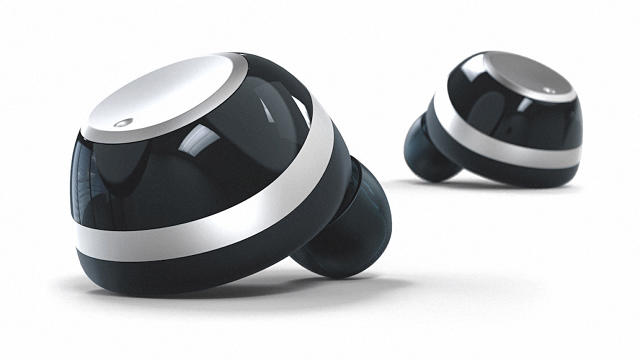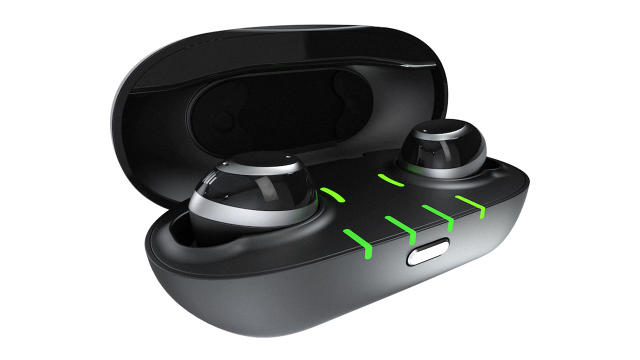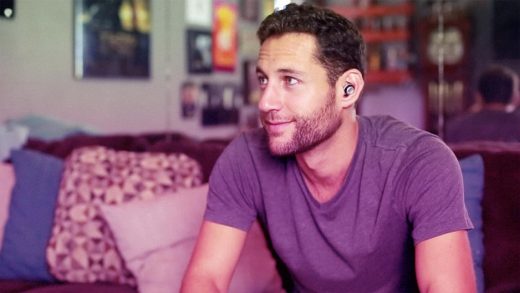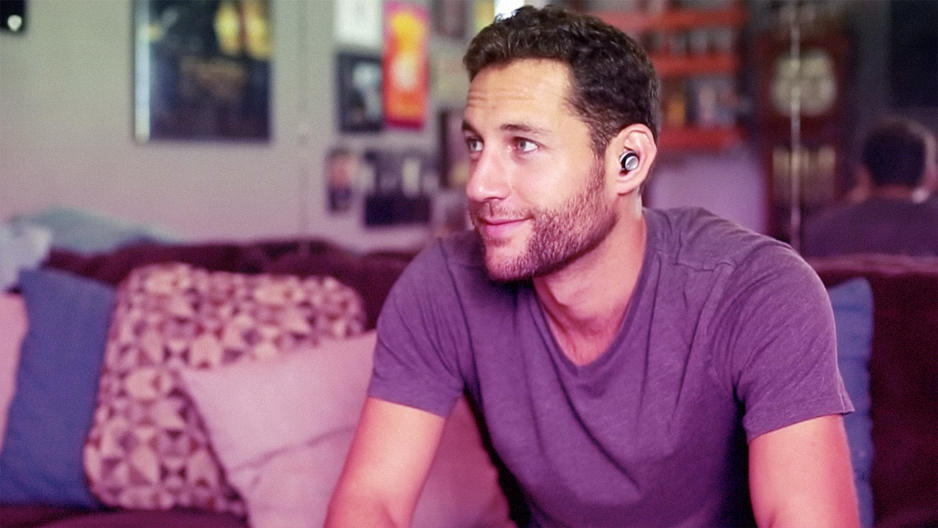How I Heard The World With Nuheara’s Bionic Earbuds
I have good hearing. In a hearing test, I can make out softly spoken words and quiet tones at a variety of frequencies. But stepping into a loud bar or restaurant, I’ll often turn around and walk right back out. Not only does the noise frazzle my nerves, I get exhausted trying to discern voices from background clatter. That puts me in the target market for a new class of smart Bluetooth earbuds, such as Nuheara’s $299 IQbuds.
Equipped with built-in microphones, the IQbuds process ambient audio in real time before feeding it to your ears. That allows you to customize how you hear, such as muting background noise, boosting the voices of people you’re talking to, or layering streaming music with ambient sounds so that both come through clearly. Though the buds, which are due to ship around March, aren’t hearing aids, IQbuds claims that they do aid hearing. It’s a delicate legal and rhetorical dance that the company hopes will provide appeal to a much bigger market than it could reach with a regulated medical device.
Nuheara isn’t alone in this market. In fact it’s been overshadowed by a very well-funded rival, Doppler Labs, which is preparing a very similar product. I have tried Nuheara’s IQbuds and Doppler’s Here One and found promise in both, but they have been prototypes with potentially deal-breaking flaws like echoes, tinny sounds, and clunky interfaces that the manufacturers assured me would get fixed in the final version.
Recently, however, Nuheara handed me a pair IQbuds fresh off the assembly line, equipped with final software, to demonstrate how well they really work.

Tin Ear?
My first question was whether IQbuds could filter out noise without distorting other sounds. It turned out that some distortion was inevitable, although the effects are often so slight that I stopped noticing. “At the end of the day, we are processing sound,” says David Cannington, the cofounder of Australia-based Nuheara, acknowledging that there will be some artifacts from the digital manipulation. As we talk in a noisy café, on a busy street corner, and especially at a crowded restaurant in downtown San Francisco, he sounds a skosh tinny, but his words are easier to distinguish than with a naked ear.
Cannington and his cofounder Justin Miller dealt with sound in much rougher settings at Miller’s previous company, Sensear. The Australian firm makes heavy-duty headsets for workers in the mining and petroleum industries. Sensear’s headsets have to block dangerous levels of background noise but filter through speech so that workers can communicate. “They’d wear bricks on their ears just to be able to hear,” says Cannington. Recent advances in headset chip technology have allowed Nuheara to pack similar capabilities into in-ear buds weighing less than 0.2 ounces apiece. (Nuheara claims up to seven hours runtime from the tiny rechargeable batteries squeezed into them.)
When Cannington and I meet for lunch at a restaurant, it’s the third time I’ve tried IQbuds, and the first time with final software. The place is practically empty, and I’m wondering how I’ll be able to judge the performance in such a quiet spot. Nevertheless, I try on the buds, inserting the tip in my ear canal and then twisting the whole device—clockwise in the left ear and counterclockwise in the right—to lock it in. It’s a similar process with Doppler’s Here One. Both products come with a selection of ear-canal tips; Cannington and I have selected small ones for my little ears. I have to occasionally twist the buds to keep them in tight. Otherwise, they feel fine.
They don’t sound fine, though: Cannington’s voice seems to be coming through an old cellphone with bad reception. It’s tinny, hollow, and echoey; and I can’t believe this is as good as it gets. It’s not. The voice-enhancing feature, called SINC (Super Intelligent Noise Cancellation), is turned up all the way. “The whole purpose of SINC is to elevate speech frequencies and to drop the background noise,” says Cannington. Hearing loss typically begins in the higher frequencies that correspond to most voices (like Cannington’s Aussie twang), and the primary goal of a hearing aid—which Cannington keeps saying his product is not—is to make voices clear.
“I think that people that come into a situation like this and struggle to separate speech from background noise are not going to worry about the tininess, because they can hear the speech,” he says. Having normal hearing, I don’t need such a boost. I dial back the virtual control knob to about three quarters on the iPhone app (the buds will also support Android), and the audio-processing artifacts mostly go away. Within an hour they will essentially disappear.
The SINC control often disappears, too. It looks almost identical to the app’s virtual knob for controlling the volume of all sound—speech, background noise, and music or cellphone calls coming in through Bluetooth. (The app, connected to the IQbuds by Bluetooth, is only required to make adjustments. The headphones can function otherwise without a phone.) Another similar-looking screen features a graphic equalizer to further emphasize or de-emphasize certain sounds. I pick a setting that softens both the very lowest and very highest frequencies to further dampen background noise.
Yet another screen features eight equalizer presets for specific environments, like Restaurant, Workout, Plane, or Music. I frantically take notes and capture screen shots, trying to make sense of all the options.

Doppler’s app, though slicker, is not so different. The audio principles remain the same, and they can be confusing to navigate. People with “real” hearing aids—those approved by the Food and Drug Administration—generally go through a fitting process with an audiologist to optimize adjustments for their specific hearing deficiencies. Prospective Nuheara or Doppler customers are garden-variety consumers who may not have documented hearing loss and just want to tweak their audio experience. (Doppler’s app does have a setup program that customizes audio settings for each ear.)
The best hearing aids from companies like Starkey, which cost thousands of dollars apiece, can assess the environment and automatically choose the right settings—something Nuheara says it would like to enable. Despite proudly showing me all the features in the app, Cannington concedes that most people won’t use them. “My belief is that a majority of people will want to elevate speech in a noisy environment, so they’ll have it in Restaurant mode,” he says.

Far From The Madding Crowd
Eventually, the quiet restaurant fills up with diners. Cannington launches a smartphone sound-meter app. It measures background noise levels fluctuating between 81 and 87 decibels—around the level (85dB) that can cause hearing damage over prolonged workplace exposure, according to the U.S. government’s Occupational Safety and Health Administration.
I take the buds out to judge if they’ve really made a difference. A roar of sound fills my ears, and Cannington’s voice recedes into the background. I have to concentrate on his specific tone to distinguish it from the general clatter. Conversing has suddenly become a chore.
Cannington smiles when I describe the experience. “This concept of stress reduction—it’s underestimated,” he says. “And what I mean by that is, you come to a restaurant like this, you start straining and increasing the level of your voice. There’s a level of stress that goes with that.” I think he’s right: My instinct is to get out of this place.
I put the buds back in and realize that I’ve forgotten about that tinny effect that annoyed me at first. Has it gone away as I made further adjustments? Have I grown accustomed to it? No matter what Cannington sounds like through the IQbuds, it’s so much better than straining to hear him without them.
“For someone like you who doesn’t have hearing loss, we’re helping you have a better hearing experience,” says Cannington. “People who have got slight hearing loss, we’re helping even more.” He’s in the latter group, with some high-frequency hearing loss, he tells me. At 57, he’s also in the 35- to 60-year old target market that Nuheara is aiming for—the age of most people who backed the product on Indiegogo.
That’s different from Doppler, whose 29-year-old CEO, Noah Kraft, is targeting more of a hipster crowd. Doppler’s ads feature attractive, fashion-forward young people, and the company promoted its previous, simpler product through sales at the 2016 Coachella music festival. Doppler does have a hearing rights advocate on staff, and Kraft says that the company could make devices to address any level of hearing loss.
The FDA recently loosened regulations for hearing aids, making it easier to purchase them without first having a medical exam. That doesn’t have any immediate effect on Nuheara or Doppler, but the FDA has also said that it wants to encourage innovation in audio products from consumer electronics companies.
Something I have learned from my experiences with these devices: Even without a diagnosed hearing impairment, there are many times in this noisy world when my hearing is impaired. It’s stressful enough to limit the places I go, or at least my enjoyment in going there. “This is the whole reason why we built the product,” says Cannington, “to take back control of that auditory world.”
Fast Company , Read Full Story
(235)



